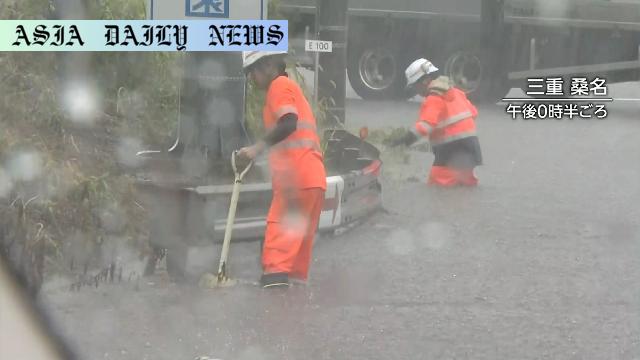Heavy Rainfall: Japan’s Tokai region faces record rains leading to heightened risks of landslides and flooding, while Shikoku braces for severe downpours.
Heavy rainfall caused record-breaking downpours in the Tokai region of Japan, sparking warnings of landslides and floods.
The Shikoku region anticipates severe rainstorms lasting overnight, increasing risks of rain-triggered disasters.
Japan’s Meteorological Agency alerts for extreme atmospheric instability across multiple prefectures.
Flash flooding warnings issued for Mie, Gifu, Aichi, and potential thunderstorm impacts remain high.

Massive Downpours Hit Tokai Region
The Tokai region of central Japan has experienced record-breaking rainfall, causing significant risks of landslides and flooding. According to Japan’s Meteorological Agency, a confluence of warm and moist air surrounding a high-pressure system has led to highly unstable atmospheric conditions. This instability has particularly affected the eastern and western Pacific sides of Japan. In Kuwana City, located in Mie Prefecture, an unprecedented 144.5 millimeters of rain was recorded in just three hours, setting a new local record for July. Gifu City saw 53 millimeters in a one-hour span, while Ichinomiya in Aichi Prefecture experienced 42 millimeters within the same period. These rains have triggered landslide warnings in dozens of districts, while several locations remain on high alert for potential flooding.
Shikoku and Western Japan at Risk
In addition to the Tokai issues, Shikoku, a region in western Japan, faces severe threats from torrential rainbands expected to continue through late Thursday night. The regions of Tokushima and Kochi are particularly vulnerable to rain-triggered disasters during this time. Forecasts indicate that Shikoku could receive up to 300 millimeters of rain over a 24-hour span up to Friday noon, a significant amount that places the area in the danger zone for localized flooding and landslides. Other areas, including the Kinki region, northern and southern Kyushu, and Yamaguchi Prefecture, could see rainfall totals ranging from 120 to 150 millimeters during this timeframe. Local officials have issued safety advisories, urging citizens to remain vigilant and prepare for emergency responses.
Impacts of Unstable Atmospheric Conditions
The combination of warm, moist air and a high-pressure atmospheric system has fueled turbulent weather patterns across Japan. This has not only resulted in heavy rainfall but also increases the likelihood of localized thunderstorms, lightning strikes, gusty winds, and even hail. Emergency services are on high alert, with resources deployed in vulnerable regions to mitigate risks and provide swift responses to evolving weather conditions. The Meteorological Agency has advised people living in affected areas to stay updated on weather forecasts and follow evacuation directives wherever necessary.
Precautionary Measures Amid Weather Warnings
Given the evolving disaster risk, residents in the Tokai and Shikoku regions are strongly encouraged to monitor local forecasts and take immediate steps for personal safety. Authorities suggest moving to higher ground for those in flood-prone areas and avoiding routes or activities in identified landslide zones. Furthermore, citizens are reminded to secure essential supplies, such as food, water, and first aid, as a precaution against any extended weather disruptions. With atmospheric instability expected to persist, early action is key to mitigating the potential impacts of these natural events. Both regional officials and national teams are working collaboratively to address emergencies efficiently, ensuring the safety and well-being of affected communities.
Commentary
Understanding the Significance of Heavy Rainfall
The recent heavy rainfall affecting Japan serves as a crucial reminder of the power and unpredictability of natural weather systems. The torrential downpours recorded in the Tokai and Shikoku regions bring to light the vulnerability of landscapes and urban areas to extreme weather events. Despite advancements in predictive meteorology, no preparation feels sufficient in the face of nature’s sheer force, making these moments stark reminders of the unpredictable nature of our environment.
The Human and Environmental Impact
While rainfall aids ecosystems and replenishes water resources, extreme occurrences like the current downpours can devastate local landscapes and uproot lives. Landslides displacing soil and flooding inundating homes cause both emotional and physical tolls on communities. Moreover, the indirect aftermath, such as disrupted transportation and economic slowdowns, underscores the far-reaching consequences of climate instability. Addressing such extreme disruptions requires deeper infrastructural support, and a collective societal will to improve resilience.
A Call to Strengthen Climate Resilience
As weather patterns become increasingly erratic due to global climate shifts, regions worldwide must prioritize adaptation strategies. In Japan’s case, it could include fortifying cities with more robust drainage systems, developing landslide-resistant materials, and enhancing public alert systems. Importantly, individuals also hold responsibility: from following safety protocols to supporting green initiatives, there are ways to unite against the long-term challenges of such climatic disruptions. These recent events in Japan highlight not just a crisis or disaster, but a potent learning opportunity for future preparation.


